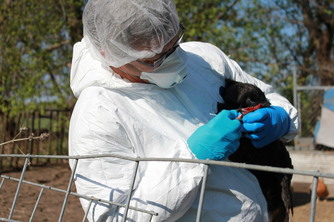 What is it?
Avian influenza is a viral disease affecting all species of birds. Similar to the flu, there are a variety of AI
strains circulating in wild birds, usually wild waterfowl.
There are two classifications of AI viruses:
-
Low pathogenic (LPAI) commonly causes mild
symptoms and birds can recover.
-
Highly pathogenic (HPAI) spreads rapidly through
flocks killing most of the birds within 48 hours.
Minnesota has experienced both types of avian influenza
in poultry flocks and continually monitors and tests flocks for avian influenza
in cooperation with industry partners. While the viruses may cause marked
illness and fatality in domestic poultry, waterfowl often show little to no
signs of infection.
How is it
transmitted? Avian influenza is spread easily from bird-to-bird through
droppings or nasal discharge of an infected bird, which contaminates the birds’
environment. People can carry the virus on their shoes, clothes, equipment, and
vehicles. Disease prevention and practicing routine, elevated and critical
level biosecurity measures are the best way to stop disease transmission.
What are the
clinical signs? Signs of low pathogenic avian influenza are typically mild,
in many cases not visible and can go easily undetected. It is similar to the common cold and can
cause ruffled feathers, some respiratory signs, and a drop in egg production.
Initial signs also include a quiet, non-active, flock and/or a drop in water
and/or feed consumption. Highly pathogenic avian influenza leads to sudden and
rapid death loss and moves through a flock more quickly; clinical signs include
loss of appetite, lack of vocalization, a drop in egg production, coughing,
swollen face, diarrhea and paralysis.
How is it
diagnosed? Minnesota’s AI surveillance program has been in place for
decades and we work with individual owners and the industry to actively look
for the disease. Every commercial poultry flock in Minnesota is tested for
influenza by the Board of Animal Health prior to going to market. All
commercial poultry breeding flocks in Minnesota are tested for influenza
monthly. Some smaller poultry flocks and live bird markets in Minnesota also
participate in AI surveillance programs. Samples from poultry flocks are
collected by Authorized Poultry Testing Agents (you can become certified during
one of our annual testing agent trainings) and submitted to either the
Minnesota Poultry Testing Laboratory in Willmar or the University of
Minnesota’s Veterinary Diagnostic Laboratory in St. Paul. Those labs test the samples submitted to
identify evidence, or the presence, of an influenza virus. If a test is positive, it is sent to the
USDA’s National Veterinary Services Laboratory to be confirmed and officially
classified. This type of surveillance is “active surveillance.” A second type
of AI surveillance is called “diagnostic surveillance,” where birds are sent to
a diagnostic laboratory and examined. If lesions on the bird are suggestive of
AI, samples are collected, tested, and if positive, sent to the National
Veterinary Services Laboratory.
Is there a risk to
people? Avian influenza viruses do not usually infect humans or circulate
among people. When they do, most infections are mild with mild respiratory
symptoms and/or eye infections in some people working directly with infected
birds. Some avian influenza viruses can cause serious illness or death. Influenza
viruses can be unpredictable, which is why poultry workers and others who have
close contact with AI infected birds should take caution, especially around
HPAI. To date, the HPAI strains found in the United States have not been
detected in humans. There is no evidence influenza is spread through food.
How can it be
prevented? Practice biosecurity, which is a term used to describe the procedures
followed by the poultry industry to contain or prevent the spread of disease in
a poultry flock. These practices include isolation, sanitation and traffic
control of people, animals and equipment. Avoid contact between wild and
domestic birds, which includes avoiding feed or water placement that may
attract waterfowl and other wild birds. Avoid on-farm traffic patterns that
cross waterways, and wear appropriate footwear that can be cleaned and
sanitized. In Minnesota, anyone who reasonably suspects AI is required to
report AI suspect flocks to the Minnesota Board of Animal Health. The Board also
works with backyard flocks to diagnose, control and prevent avian influenza.
|